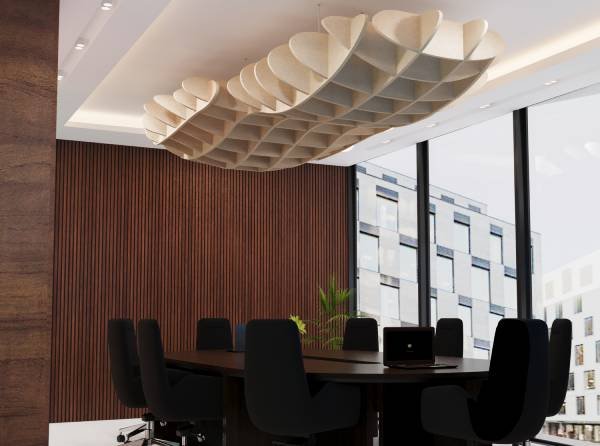Acoustic boards help lessen undesirable reflected sound in any room...
Acoustic ceiling options are a cost-effective solution to lower ceilings in spaces that require technologies to absorb and muffle ambient sound. To create such a ceiling, a grid network of light metals is suspended from the main ceiling, creating a surround in which sound-absorbing panels can be placed. The ceiling tiles come into play at this point. There is a space between the main ceiling and the acoustic ceiling that can be used to instal and conceal wiring, lighting, and plumbing components. This is advantageous because any installations will still be conveniently accessible in the event that maintenance is required.


The popularity of acoustic ceiling tiles peaked in the 1960s and continued through the early 1980s. Because they initially contained asbestos, the prohibition on asbestos in 1978 had a significant impact on the production of acoustic ceiling tiles. Many customers had to pay professionals to remove asbestos-containing acoustic ceiling tiles and replace them with alternative materials, or to restore rooms to their original bare ceilings.
Companies have yet to fully comprehend the transformation that can occur when acoustic ceilings are installed. An effectively organised acoustic ceiling tile grid can have a significant impact on a room, particularly in offices or institutional settings such as hospitals or schools. Controlling the sound quality of an area can be done in a variety of ways. Installing an acoustic ceiling system is one of the most effective and efficient choices available. These structures aid in improving speech intelligibility while also screening against unwanted external or distracting sounds.
The way these ceilings are arranged and put together has an impact on their overall performance. The main feature of this sort of ceiling is that it absorbs sound. Coloured acoustic ceiling tiles are a critical component in assisting potential purchasers in making a decision. Sound absorption helps to reduce not only general sound levels, but also specific frequencies that can create distraction or lack of concentration in the workplace.
Acoustic systems reduce noise levels by absorbing sound inside the ceiling structure and controlling echoes and reverberations in any room. This is in contrast to merely sound insulation, which focuses entirely on protecting a building’s interior users.
The most significant benefit of acoustic ceiling tiles is that they reduce noise transfer between floors of your home or building. They can also be simply painted to complement the room’s décor or colour scheme. Acoustic ceiling tiles, on the other hand, have some disadvantages. They discolour if they get wet, and the pooled water on top can cause them to fall over. Furthermore, acoustic ceiling tiles stain badly and must be bleached to restore their natural appearance after water damage. However, if one of the acoustic ceiling tiles has to be replaced, it is rather simple to do so.
What should you know about commercial acoustic ceiling tiles, their purpose, and why they’re so popular? I’d heard about acoustic ceiling tiles before, but hadn’t given them much thought until I needed to put a ceiling in my basement. I had no idea what they were, but after some investigation, I learned a lot about acoustic ceiling tiles. Here’s a sampling of what I discovered. Examine them to see what they are and whether or not they are appropriate for you and your ceiling condition.
Only you will be able to tell if you require acoustical ceiling clips for your ceiling demands. However, if you want to reduce sound between levels of your home or business without spending a lot of money on renovations, think about them. Acoustic ceiling tiles from Unidus are simple to replace, inexpensive to maintain, and allow you to paint the ceiling to match the rest of the room’s decor. When it’s time to replace your ceiling, consider acoustic ceiling tiles. You could be amazed at how nice your new look is without spending a lot of money.
Acoustic boards help lessen undesirable reflected sound in any room...
Acoustic boards help lessen undesirable reflected sound in any room...
Open spaces have been known as the trending layout for...
WhatsApp us